Brand new KEF Uni-Q Meta drivers are available on ebay from HK sellers. Not cheap but only marginally pricier than the Satori coax & it looks genuine.Harvest the drivers from a pair of Q350’s then…..the Meta material advantage can be realized without the price tag and mambo jumbo…….put the Uni Q in a larger enclosure with walls well lined and add an aperoidic vent……nearly the same results….at least to the point that maybe…..maybe you can hear a difference…….unless sighted listening is your thing.
If looking to clone the Blade 2, the woofers don't seem hard to replace with drivers available to DIYers, and there's lots of known ways to couple a pair for vibration cancellation. DSP & active crossovers would be the obvious way for most DIYers. The real challenge is the enclosure, since every external plane features complex curves. But tear-drop cross-section profile towers can be made with stacking CNC-cut BB plywood or skinned with multiple layers of thin BB around tear-drop shape ribs. Not quite as organically curved as the Blade, but it would likely be close enough. Though some vertical curvature could probably be worked in with progressively larger ribs in the middle. Obviously a challenging woodworking project.
The main question I have is whether a 100 degree frontal dispersion window is enough. After recent successful exploration of omnidirectional designs, I suspect the narrower directivity may not be for me. Still haven't really auditioned a controlled directivity loudspeaker system yet; would love to hear a well-liked pair.
Last edited:
i would wait until the meta technology arrives in the mass market sellers Q-series, i guess next year
in the Q series with no additional woofers at time Q100 and Q150 the value is let's say minimum 80 percent in the drive unit of the uniQ driver, cabinet and crossover are low quality
i have done some testing builds with the KEF SP1632 mid-high range coax with FA123 plate amps, not too bad with the active crossover

have taken some measurements with extended bass response - the Sonido drive units in the CB enclosure gave no bass
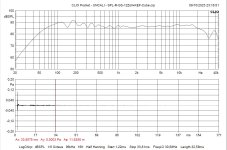
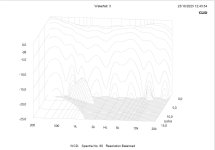
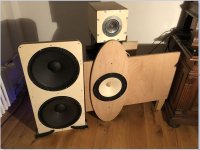
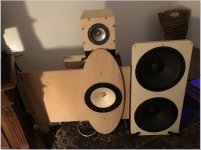
i was lucky to purchase the drive units as spare parts from setelec.fr but they have discontinued the KEF spare parts delivery in 2023
this other KEF drive units are waiting for testing since years

there is a chance to get officially the in wall KEF speakers, but the price of my favourite one is much too high
https://eu.kef.com/products/ci200rs
in the Q series with no additional woofers at time Q100 and Q150 the value is let's say minimum 80 percent in the drive unit of the uniQ driver, cabinet and crossover are low quality
i have done some testing builds with the KEF SP1632 mid-high range coax with FA123 plate amps, not too bad with the active crossover
have taken some measurements with extended bass response - the Sonido drive units in the CB enclosure gave no bass




i was lucky to purchase the drive units as spare parts from setelec.fr but they have discontinued the KEF spare parts delivery in 2023
this other KEF drive units are waiting for testing since years
there is a chance to get officially the in wall KEF speakers, but the price of my favourite one is much too high
https://eu.kef.com/products/ci200rs
Last edited:
beside the high prices some interesting KEF in wall drive units here
https://eu.kef.com/collections/architectural-speakers/feature_thx
https://eu.kef.com/collections/architectural-speakers/feature_thx
The Blade has it‘s placement limitations for sure……side wall reflections have to be considered and as such
Why is this a bad thing? Sidewalls reflections are often beneficial if the design is good. If you have poor directivity then the sidewall reflections will be a detriment. But that's not the case here with the KEF Blade 2 Meta which has some of the best DI available commercially.
Not that it matters because these aren't much different in horizontal beamdwidth than "standard" speakers with forward firing drivers which are omnidirectional up to about 300-500hz (depending on driver/baffle size, of course) and narrowing above this. Above this frequency range most flat baffle speakers are going to be ±50-70° up to about 8kHz where they begin narrowing again. Most waveguided or horn loaded designs are going to be about ±30-60° up to about 12kHz (or even 20kHz if designed well). These all have sidewall reflections.
More concisely: the KEF B2M having side-firing woofers doesn't mean it automatically has more sidewall reflections than any other typical speaker. It's radiation is narrowed to ±90° by 300Hz which is lower in frequency than many other speakers. You can even compare it directly to the KEF R11 Meta - using (4) 6.5-inch midwoofers and a concentric mid/tweeter - which doesn't narrow to ±90° until 600Hz. Which means that there are technically less sidewall reflections in this speaker's design than the majority of other forward-firing designs. I've got tons and tons of data on my site if you'd like to fact check me.
I don't know if it matters either but what you say there isn't quite right. The comparison of your Blade measurements and Amir's of an R11 on the previous page show the difference. Most forward firing drivers in a basic box are omnidirectional to about 150Hz (The driver or baffle has to quite large to change this much at all at the bottom end) and then progressively narrow.Not that it matters because these aren't much different in horizontal beamdwidth than "standard" speakers with forward firing drivers which are omnidirectional up to about 300-500hz (depending on driver/baffle size, of course) and narrowing above this.
The Blade with side firing drivers are much more omnidirectional up to about 250Hz. The side firing drivers counteract the natural baffle diffraction as measured from the front. There is often no need to apply baffle step compensation in the crossover design or at least much less.
@fluid explained exactly my point, it is quite the same with the BoxSim simulated placement of woofers difference keeping all the rest - drive units, enclosure dimension etc. etc. the same
if a better directivity transition without bumps is desired already at low frequencies you have to place 2 of the woofers backfiring and work with delay with a DSP crossover with the front firing stuff
these guys are doing it extensively with a completely other form of the enclosure with a large baffle and only a small depth
https://ggntkt.de/en/
P.S.:
i would like to see what Dirac Live would have to correct under the Schröder frequency in a normal room with the Blades placed without > 150 cm from the back and the side walls - with such a placement opportunity i would take a dipole firing speaker system anyway
if a better directivity transition without bumps is desired already at low frequencies you have to place 2 of the woofers backfiring and work with delay with a DSP crossover with the front firing stuff
these guys are doing it extensively with a completely other form of the enclosure with a large baffle and only a small depth
https://ggntkt.de/en/
P.S.:
i would like to see what Dirac Live would have to correct under the Schröder frequency in a normal room with the Blades placed without > 150 cm from the back and the side walls - with such a placement opportunity i would take a dipole firing speaker system anyway
Last edited:
Oh those GGNTKT speakers are cool!
IMO Erin is spot on.
I think we need to be careful when looking at this data. Spinoramas have a fixed rotational axis that is usually set at the front baffle. When you rotate about that axis, drivers mounted on the sides and back get 'artificially' louder simply because the box dimensions push the drivers closer to the mic. If the rotational axis were set at the centre of the cabinet that effect would be lessened, but the curves for the midrange up would fall off artificially rapidly. This is not directivity, only box dimensions and measurement distance in effect - we all know the blade are omni at 30 Hz but the plots show otherwise, just slightly.
You can see this in the horizontal SPL curves, they have been matched at about 150Hz for the B2M.

It's even visible in the early reflections data for the GGNTKT speakers with rear woofers, the curves have been matched at 350 Hz.

IMO Erin is spot on.
I think we need to be careful when looking at this data. Spinoramas have a fixed rotational axis that is usually set at the front baffle. When you rotate about that axis, drivers mounted on the sides and back get 'artificially' louder simply because the box dimensions push the drivers closer to the mic. If the rotational axis were set at the centre of the cabinet that effect would be lessened, but the curves for the midrange up would fall off artificially rapidly. This is not directivity, only box dimensions and measurement distance in effect - we all know the blade are omni at 30 Hz but the plots show otherwise, just slightly.
You can see this in the horizontal SPL curves, they have been matched at about 150Hz for the B2M.
It's even visible in the early reflections data for the GGNTKT speakers with rear woofers, the curves have been matched at 350 Hz.
Because parallel reflections below 200hz are going to create notched boundary gain and most likely they’ll also be corners so they’ll load up even more…..not to mention the slap back delay. The acoustic effect of nearfield boundaries are profound when recording a source with a mic……speakers are no different.…….the reverberant field is obvious and as such never requires measurements to make decisions…and so should be with complex music……test tones and noise will only take you part of the way.Why is this a bad thing? Sidewalls reflections are often beneficial if the design is good. If you have poor directivity then the sidewall reflections will be a detriment. .
Facts are facts…..I’ll give you that of course and no discredit to the hard work you put in…..but it’s the interpretation of the facts and data that give me pause. At the end of the day, the closest we can get to representing what the speaker is doing is to measure at the listening position in the actual space.……I wouldn’t expect you to have that data as for the purpose of reviews, it’s quite meaningless to your viewers if taken at face value and sighted interpretation.. I've got tons and tons of data on my site if you'd like to fact check me.
For the sake of your viewers, you can choose to dismiss diminishing returns on price and performance but the reality still exists…….at $6500 or so for a pair of R11 meta and the Blade at 4x that price, with adjustments to placement accordingly and given the available data, for me….the choice would be easy….even from a DIY standpoint as the construction of a WWCWW in line is going to be MUCH easier than that of the blade. Who could state within the confines of the comparison that the Blade represents a 4 fold improvement in performance?.….or even double? Place each behind a screen and AB them back and forth?………add enough test subjects and you’ll get a 40/60 or 60/40 result once you remove the suggestive bias of the gorgeous Blade enclosure.
Honestly, as the OP, none of this is relevant to my path anymore anyways…….I’ve decided to build 11” floating spheres for the Uni-Q drivers over one up firing and one fwd firing 10” woofer. If my assumptions are correct, this is going to be one hell of a point source representation.
Last edited:
For the sake of your viewers, you can choose to dismiss diminishing returns on price and performance but the reality still exists
Yikes. You misunderstand me and my intentions. That's unfortunate because I really hope people understand the reason I am in this is because it's a passion. It's not to try to push products. I've been testing for about 14 years now and have always made the data publicly available. I didn't get into the YouTube space until about 4-5 years ago.
I review products from $80/pair to tens of thousands per pair. And I try my best to explain what the data means and help viewers understand what matters to them. I don't dismiss diminishing returns. However, at the same time it's nice to have data on just exactly what those 'diminishing returns' are.
Let's take an easy example like drive units: a cheap Vifa woofer is linear within a certain region just the same as an expensive Scan Speak woofer. If you need a 7-inch midwoofer to play 100Hz to 2kHz then there probably isn't a lot of benefit in buying the expensive one. The difference outside of the pistonic region where beaming becomes a factor or excursion is a factor are the areas where the additional costs might make more sense for the user who are trying to eek out as much performance in a particular size class as they can.
And, of course, more money doesn't always equal better performance.
Let's talk about money with real world use case, as well. IME $500-1000 for a pair of bookshelf speakers is the sweet spot. You can get a lot of product for the price here. Above this you are typically paying for the aesthetic (gloss finish, etc). Sometimes curved baffles which also helps improve performance to some degree. Sometimes you are paying for higher quality components (more linear drivers, drivers with lower inductance and reduced IMD, legitimately better crossover components with higher tolerance and better speaker/pair matching). That's where data helps us determine if a $2k/pair bookshelf speakers is objectively better than a $500/pair speakers or if you're paying pretty much $1500 for looks alone. I just had this conversation with Laurie Fincham on the phone a few weeks ago.
Last edited:
I don't know if it matters either but what you say there isn't quite right. The comparison of your Blade measurements and Amir's of an R11 on the previous page show the difference. Most forward firing drivers in a basic box are omnidirectional to about 150Hz (The driver or baffle has to quite large to change this much at all at the bottom end) and then progressively narrow.
The Blade with side firing drivers are much more omnidirectional up to about 250Hz. The side firing drivers counteract the natural baffle diffraction as measured from the front. There is often no need to apply baffle step compensation in the crossover design or at least much less.
Look at the horizontal contour plot of my speaker measurements. The large majority of them are ±180° to about 300Hz - 500Hz depending on size, of course. But that's pretty much par for the course. (±6dB, normalized)
The KEF B2M is to about 300Hz. The KEF R11 Meta is about the same. The Neuman KH80 is to about 500Hz.
Now, if you want to get outside of the "norm" and talk about larger speakers with larger baffles then you can look at the JBL 4367 which is omni up to about 200Hz (again, ±6dB normalized).
Just to note, I was talking about ±90° previously due to the conversation being based on sidewall reflections. I want to make sure we're on the same page here.
and most likely they’ll also be corners so they’ll load up even more…..not to mention the slap back delay.
Honestly, I can't imagine anyone spending $28k on these speakers and sticking them in corners. I'm on a few different Facebook groups and one of them is a KEF group. I've seen a decent bit of user photos showing off their Blade setups and none of them have been in corners. I literally just now pulled up one of the groups (KEF Enthusiast Group) and searched for "Blade". I saw 15 pictures and none of them were in the corners. The closest I saw was at least 3-5 feet away from the nearest sidewall. Backwall, however, some had them a couple feet.
GGNTKT speakers
Alternate ways of doing things.
Let’s introduce th push-push Monitor Audio to the discussion. What happenbs when you put the woofers on the inside and slot load them?
Perhaps this would work for mayhem.
BTW, the bipole dip is why the DSP is udes in the GGNTKT. The wider than deepbox makes this issue smaller in a bipole.
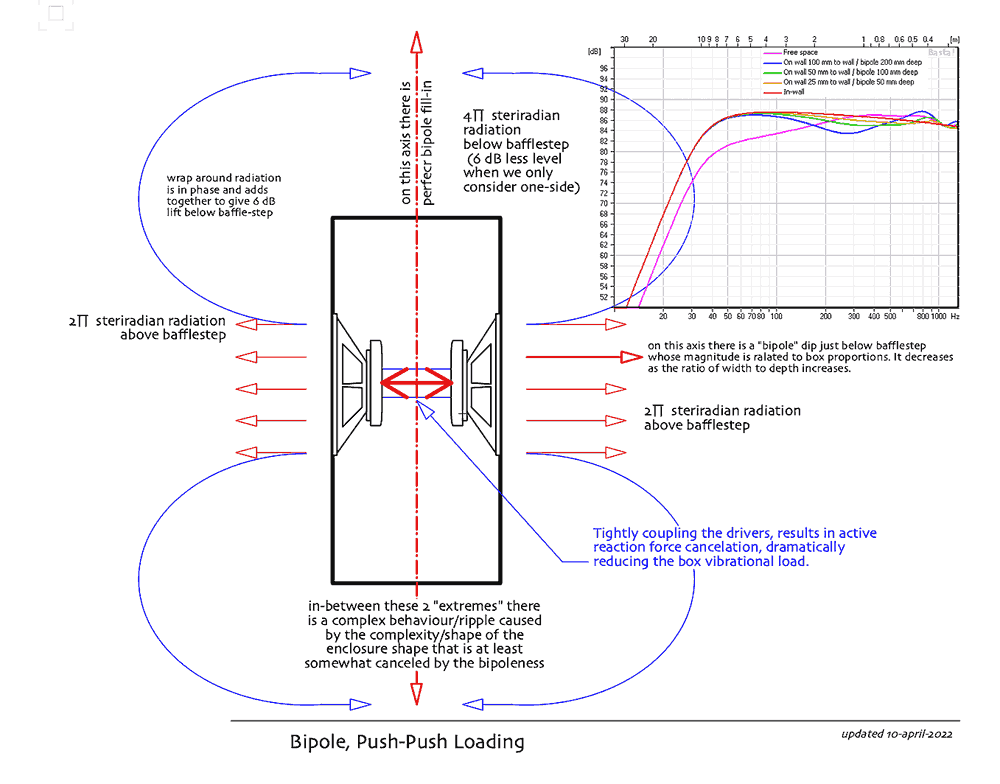
dave
Along the lines of what you said 3 posts back, it would be real interesting to have your level of review data on Reference series vs R series. Yes, the R11 meta is very reasonably priced but is the Reference series equivalent worth the additional $10K or so?
I’ve reviewed the Reference 1 Meta and the R3 Meta. And made a comparison video:
KEF R3 vs R3 Meta vs Reference 1 Meta. Why such a big price gap?
https://youtube.com/live/Cid2pvptWFY?feature=share
IIRC, the R1M is more linear, lower in distortion and lower in compression. But you’d have to double check me on that.
Alternate ways of doing things.
That’s a good looking speaker IMHO. Which model is that?
Edit: never mind. I zoomed in on the picture and saw it’s the M3.
Last edited by a moderator:
The slot is open to front and back, right?
They are using vituixcad! Can be seen in the design video
Being close to boundaries is typically not great for any frequency range. I don't think the woofers being 12" or so from the side walls is gonna be the biggest problem of this kind lousy placement.There’s NO WAY that woofers firing right against side walls down to 40hz are not going to be problematic…..the laws of physics still exist and directivity isn’t an epiphany.
- Home
- Loudspeakers
- Multi-Way
- KEF Blade 2 meta vs Reference 5 meta?…..which is better?